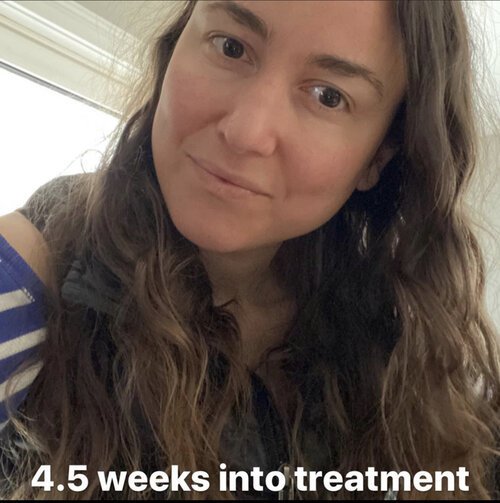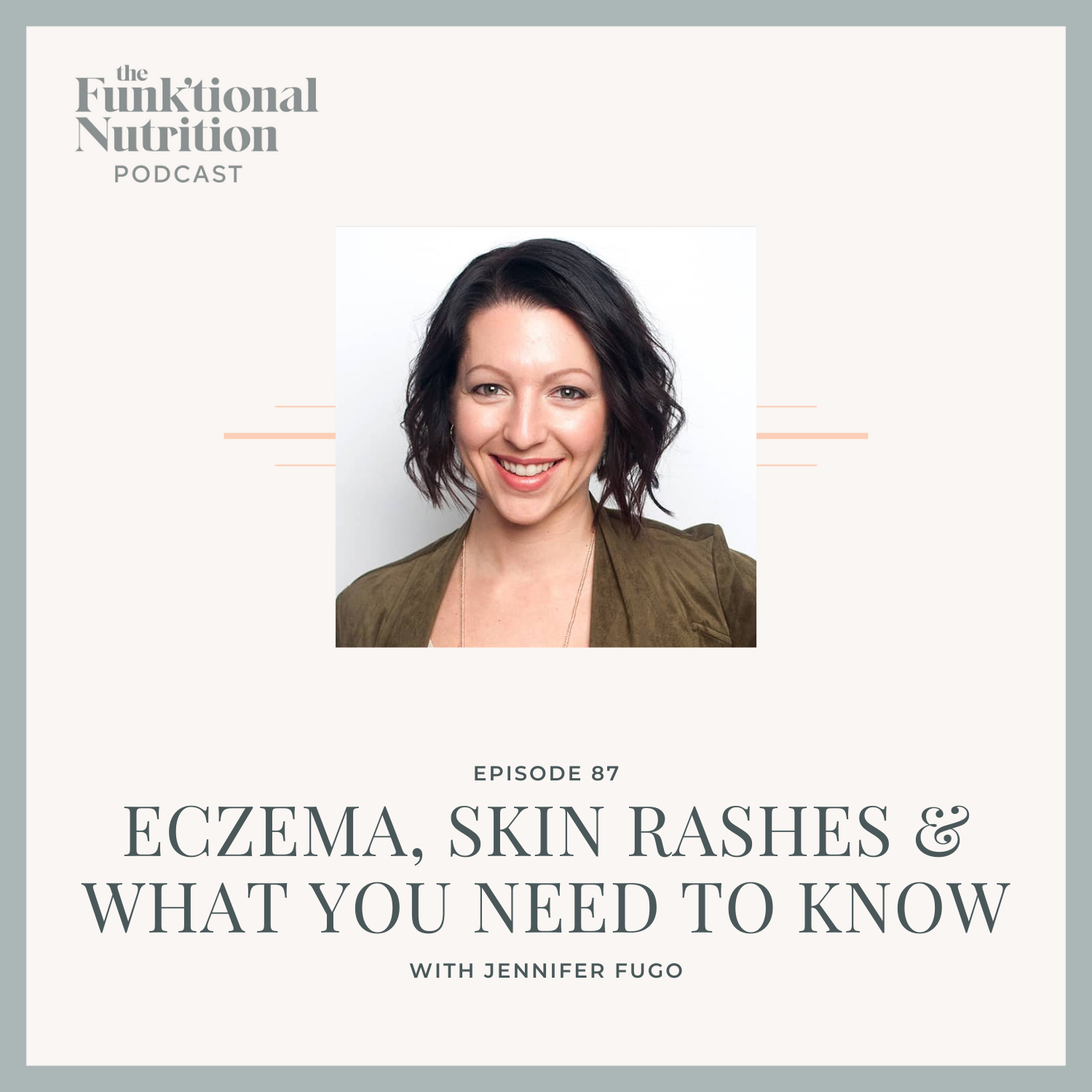Functional Medicine

Healthy Skin
Skin is an inside job!
A lot of people think that skin is a topical issue. Maybe you just need a better skincare routine or more facials. While sometimes that can be super helpful (and if you’re here to check out my skincare routine, be sure to scroll all the way down!)…but rarely it’s enough to create big, lasting change.
Conventional/allopathic medicine echoes this “topical” sentiment and tends to focus on the organ in question. For skin issues, the solutions are always skin-focused. Dermatology, steroids, cortisone creams, Acutane, etc. They work from the outside.
The truth of the matter is that skin is almost always an inside job. Sometimes it's hormones. Sometimes it's overburdened detoxification pathways. Often it's gut-related.
Our functional medicine nutrition approach to healthy skin is different. We take a step back and ask: what's driving the imbalance? What are the triggers? Where did it start? How can we address the root so the organ can self-heal?
These are the questions we ask in our clinical practice here at The Funk’tional Nutritionist. And this is how we address skin issues from the inside-out.
With skin imbalances, there's often issues with:
Inflammatory diet
Nutrient deficiencies
Food intolerances
Gut health
Liver & toxic burden
Hormones
Let’s get into it!
Skin Food: Eating for Healthy Skin
Hydration
We’d be remiss if we didn’t at least mention this. Our skin can become dry and lackluster if our bodies are dehydrated, so the very first step to nourishing your skin is drinking plenty of water.
Be sure to read How to Heal & Prevent Dry Skin if this is an issue for you!
Proper Nutrition
Like everything in the body, the skin thrives on specific nutrients.
Skin Nutrients
Zinc, selenium, iron, iotin, vitamin C, vitamin D, vitamin A, vitamin E, mega-3 fats, and protein.
GLA
GLA, or gamma-linolenic acid, is kind of an unsung hero when it comes to skin health. Supplementing with GLA has been shown to improve dry skin & atopic dermatitis.
GLA can be found in hempseed, borage oil, evening primrose oil, black currant oil, and sea buckthorn.

Our face is a window into our gut.
What are you eating?
Unfortunately, our modern diets are lacking in many of these important skin nutrients. On top of that, we’re eating lots of foods that promote inflammation. Since skin conditions are often an issue of systemic inflammation, in order to heal the skin, you must remove (or dramatically reduce) anything that’s triggering the inflammation.
This includes pro-inflammatory foods like refined sugars, processed carbohydrates, omega 6 fats, additives, and alcohol. (Don’t shoot the messenger!! Booze feeds the bad bugs in our guts, messes with gut lining & increases estrogens. Definitely limit your use if you’re trying to improve your skin!!)
The first step in healing skin is switching over to a nutrient-dense, whole foods diet that limits processed foods. The nutrition plan Eat to Achieve outlines exactly how to do this.
ID & Eliminate Specific Food Sensitivities
When you eat a food that you’re sensitive to, it inflames the gut, and then that inflammation can show up on skin.
Two ways to identify food intolerances:
An elimination style diet, like Phase 3 of the Eat to Achieve nutrition program.
Or invest in food sensitivity testing using a trusted company. The testing we use here provides the most in depth and accurate look at food reactions. BUYER BEWARE: We never recommend food sensitivity testing unless you have a skilled clinician helping you discern the appropriate time to test AND what your results mean!
Skin-Gut Connection
Did you know our skin has its own microbiome? And guess what? Our gut microbiome determines our skin microbiome! That means our skin is influenced by the SAME things that our gut is. Erin goes into all sorts of detail about this in these two episodes below.
Many of you already know that your skin is your largest organ, but we often forget that addressing skin conditions often requires us to go beyond topical solutions. Conventional/allopathic medicine tends to focus on the organ in question. For skin issues, the "solutions" are always skin-focused with treatments like dermatology, steroids, cortisone creams, Acutane, etc. They work from the outside.
The truth of the matter is that skin is almost always an inside job. Sometimes it's hormones. Sometimes it's overburdened detoxification pathways. Often it's gut-related. Functional medicine likes to take a step back and ask, what's driving the imbalance? What are the triggers? Where did it start? How can we address the root so the organ can self-heal?
The conversation continues on part 2 discussing leaky gut, specific skin conditions, how they often manifest and important things to consider for them.
This episode is definitely for you if you’ve been suffering from a common skin condition like rosacea, acne, eczema, keratosis pilaris or psoriasis. Erin also talks about histamines and candida, and weaves information throughout the episode that’s really important to hear from a holistic perspective.
This is a comprehensive, high-level gut-skin conversation with licensed naturopathic doctor and integrative dermatology specialist Dr. Julie Greenberg. She goes deep on a host of topics, especially the roles of specific gut bacteria seen in clients with common skin conditions such as acne, eczema, psoriasis and rosacea. You may want to bust out a pen and paper for this one!
Want to get even deeper on this connection?
Episode 129
Not quite sure how to eat for gut health?
Have a listen to episode 129 The Funk’tional Nutrition Podcast! FYI: this is the #3 top downloaded episode of all time!
How’s your skin look?
Skin is one of the first (and sometimes only!) places to show that there is a problem in the gut. Issues with your skin can be a sign of poor digestion, low stomach acid, leaky gut, gut pathogen and/or dysbiosis. If this sounds like you, be sure to grab our free digestive support guide. This guide is also important if you find that you don’t tolerate fats well. Our skin needs fatty acids, so if we can properly break down our fats, that’s a big time skin problem!




Rosacea
Rosacea is heavily linked with SIBO (small intestinal bacterial overgrowth). In fact, the prevalence of SIBO in rosacea can 60% or higher! Treating the SIBO can alleviate the rosacea. There's also a link between rosacea and H. Pylori. Erin is personally no stranger to SIBO—or rosacea! She’s had to treat it on and off in the past, but once she addressed the underlying cause—for her, that was motility issues—she’s pretty much had it under wraps for several years!
Erin says: These photos are unedited, no filter photos from when I was treating myself for SIBO. The first two are at the start of treatment, the 3rd is two weeks into treatment - I was wearing makeup for work: Beauty Counter Dew Skin & Tint Skin. The final photo was four and a half weeks into treatment and most of the rash had resolved. (Scroll down for current photos of my skin - after treatment!)
Below is a positive SIBO breath test. There’s a very high chance that if you struggle with rosacea, you also are positive for SIBO!
Acne
37% of people with acne have gut symptoms, and 40% have low stomach acid. Food sensitivities can also be a huge trigger for acne, with dairy being the most common.
Other signs of a dairy sensitivity include:
Bloating, diarrhea or constipation
Eczema, rashes or atopic dermatitis
Mucous-filled cough
Runny nose or ongoing sinus issues
Headaches and migraines
If you have not done so already, remove dairy from your diet to see if your skin improves.
Female acne can also be caused by higher levels of androgens (testosterone and DHEA).
If you want to know if this applies to you, you can get your hormones tested in Your Hormone Revival, the 13-week process to test & rebalance your hormones. Using the DUTCH hormone test, this program provides direct insight to your hormones as well as an individualized protocol to tell you exactly what you need to do to work toward hormone balance.
The real culprit here is blood sugar imbalance. Insulin surges cause major shifts in hormones by activating an enzyme that increases testosterone and DHEA.
The solution is to get better control of your blood sugar and insulin. The Carb Compatibility Project is the exact plan to do just that!
Eczema
Poor gut bacteria and food sensitivities are the two biggest culprits of eczema. Dairy and gluten are the most common, so testing for these and/or removing them are best places to start. Eat to Achieve is a gluten-free, dairy-free food plan.
Histamine intolerance can also be at play with eczema. In our clinical experience, histamine issues often appear with H. Pylori infections, candida overgrowth and low Bifido species in the gut. Consider supplementing with a heavy duty probiotic. If that doesn’t help, consider functional GI testing through the private membership.
EPISODE 87
Eczema, Skin Rashes & What You Need to Know with Jennifer Fugo
This interview with clinical nutritionist Jennifer Fugo dissects chronic skin conditions such as eczema, skin rashes, seborrheic dermatitis, dandruff and yeast, rosacea, and psoriasis. You’ll hear how the intersection between the various systems within the body can affect these conditions and important things to consider for skin health!
Liver & Detoxification
Acne, skin rashes, rosacea, and other skin problems can all be signs of an overwhelmed liver and overburdened detoxification pathways. Your liver acts as a filtration system that prepares toxins to be excreted out through your lungs, kidneys, gut, and….SKIN! In an ideal world, our bodies (and liver) should be able to handle everything that is thrown their way. But the modern world is far from ideal...at least as far as toxins are concerned.
Over 80,000 synthetic chemicals have been introduced to our environment, and most of them have not been tested for human safety.
The first step is to avoid & remove exposure. In other words...lighten the liver’s load before it even begins. In order to do this, we must be conscientious of the toxins coming in the first place. One super overlooked source of everyday toxins? YOUR SKINCARE! Your liver is your second largest organ—your skin is your first! Everything we put on our skin enters the bloodstream and is then passed on to the liver. Think how that might affect you if you’re constantly bombarding your skin with unsafe ingredients.

I love me a disruptor, but not when it comes to my hormones!
So much of what we’re using on our skin to help our skin is causing a lot of other problems.
Most conventional skincare and personal care products contain endocrine disruptors: environmental chemicals that can disrupt endocrine receptor signaling. Put simply: these ingredients scramble up your hormones—and your metabolism!
Working with women in Your Hormone Revival, we see a LOT of health issues related to estrogen dominance. If you have heavy or irregular periods, bad PMS, breast tenderness, fibroids, endometriosis, cystic ovaries...LISTEN UP!
Many popular products (even the luxury ones) contain xenoestrogens, which are chemicals that mimic estrogen in the body and interfere with our own estrogens. This creates a hormonal imbalance in the body.
To make matters worse, if you have poor liver detoxification, or poor gut function, you’re unable to get rid of these estrogens properly. This leads to even MORE hormonal imbalance and symptoms.
“But I only use a few products.”
Unfortunately, this is NOT a case of the dose makes the poison.
Environmental toxins can be a problem AT VERY LOW DOSES. Because your body is used to responding to your own hormones at low doses, it will respond to endocrine disruptors at low doses, too! These chemicals can rev up and slow down certain hormones, and can even damage glandular tissues, like the thyroid, and ovaries.
If you don’t think cosmetics matter, you’re wrong.
Did you know that the average American puts up to 20 products on their bodies every day?!
Soap, toothpaste, perfume, cologne, deodorant, makeup, lotion, shampoo, conditioner, lip balm, shaving cream, pomade, body wash, eye cream, nail polish, hairspray…it adds up quick!
Phthalates from cosmetics accumulate
in your body!
The CDC has measured metabolites of phthalates in 98% of people tested!
Phthalates are used as a fixative in fragranced products. So ANY product you use with fragrance has phthalates. Go ahead and look at your personal care product labels. Try to find something without fragrance. We’ll wait.
You probably won’t have much luck because fragrance and phthalates are everywhere. The real reason this is a problem is because these chemicals are linked to: ADHD, Autism, behavioral disorders, asthma, breast cancer, testicular cancer, reproductive birth defects, early onset puberty, thyroid dysfunction, weight gain and obesity, diabetes and insulin resistance, sperm damage and reduced fertility in men and women.
How’s your perfume smell now?

Not interested yet?
What if we told you that some of these chemicals are considered obesogens, due to the effect they have on our weight. Chemical load in the body is associated with body fat. It’s actually a protective mechanism! Our body fat is a storage system for chemicals, so we can protect our tissues and brain from toxic overload. The body load of certain chemicals also correlates with metabolic syndrome, and play a significant role in the development of diabetes.
Now you can see why we only use clean beauty products. Erin dives into much more detail about environmental toxin exposure in the episode below, covering not just fragrances in beauty products, but also in everyday cleaning and other products many use daily.
EPISODE 167
Fragrances, Hormones & Small Steps to Non Toxic Living
This episode dives into the details about fragrance effects on hormone health and lays out what to be aware of in products we often use on our bodies or in our home. The linked resources also provide a TON of studies and further reading on this topic!








THE FUNK’TIONAL NUTRITION PODCAST














